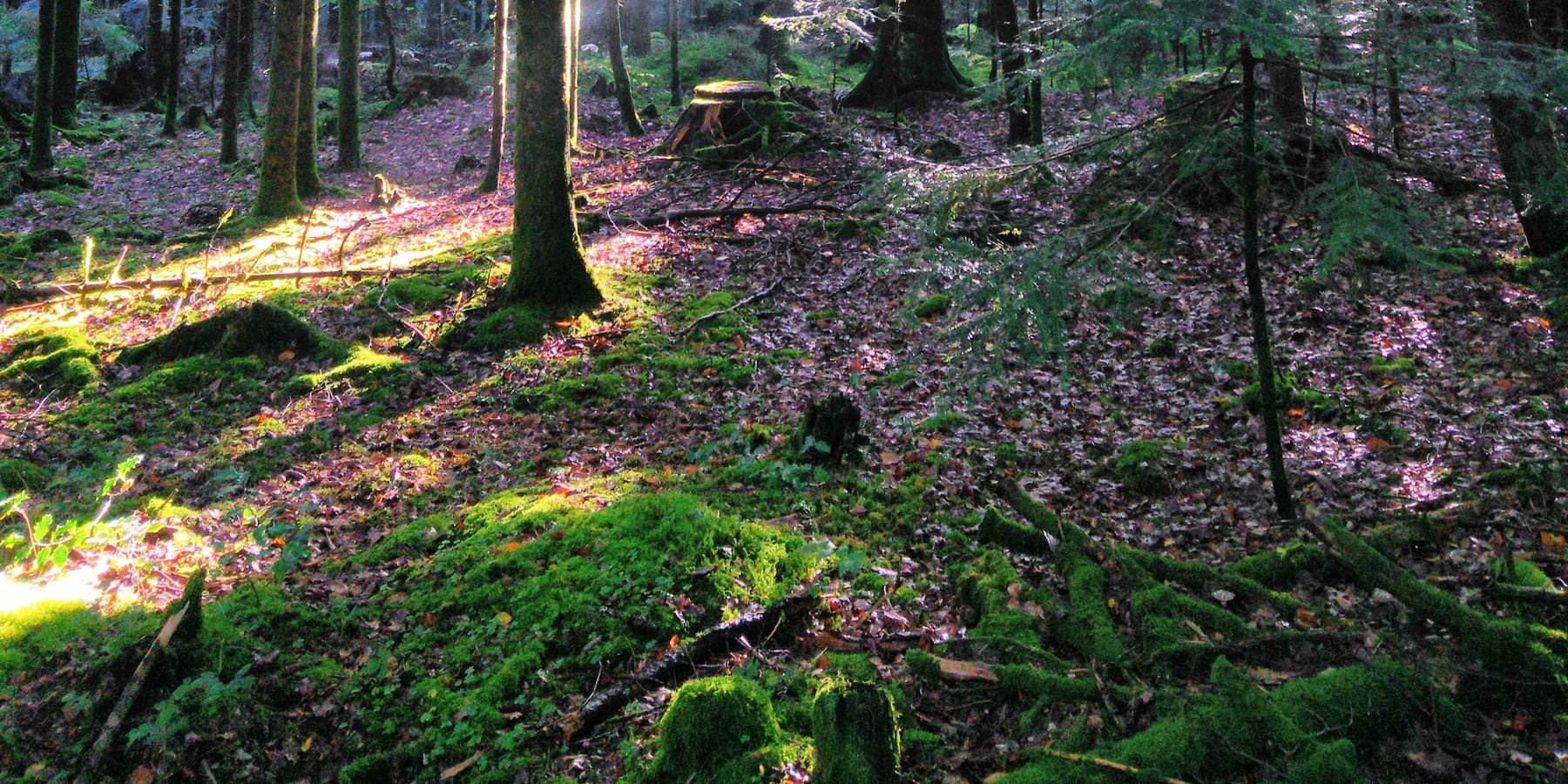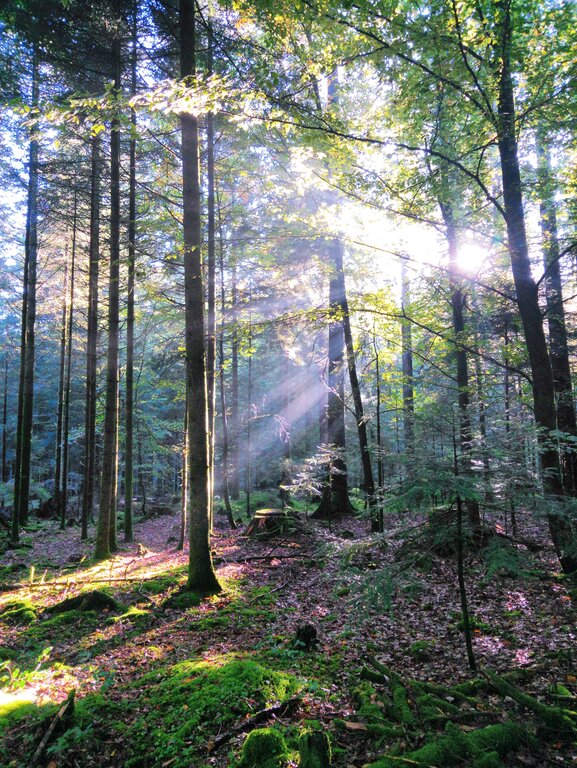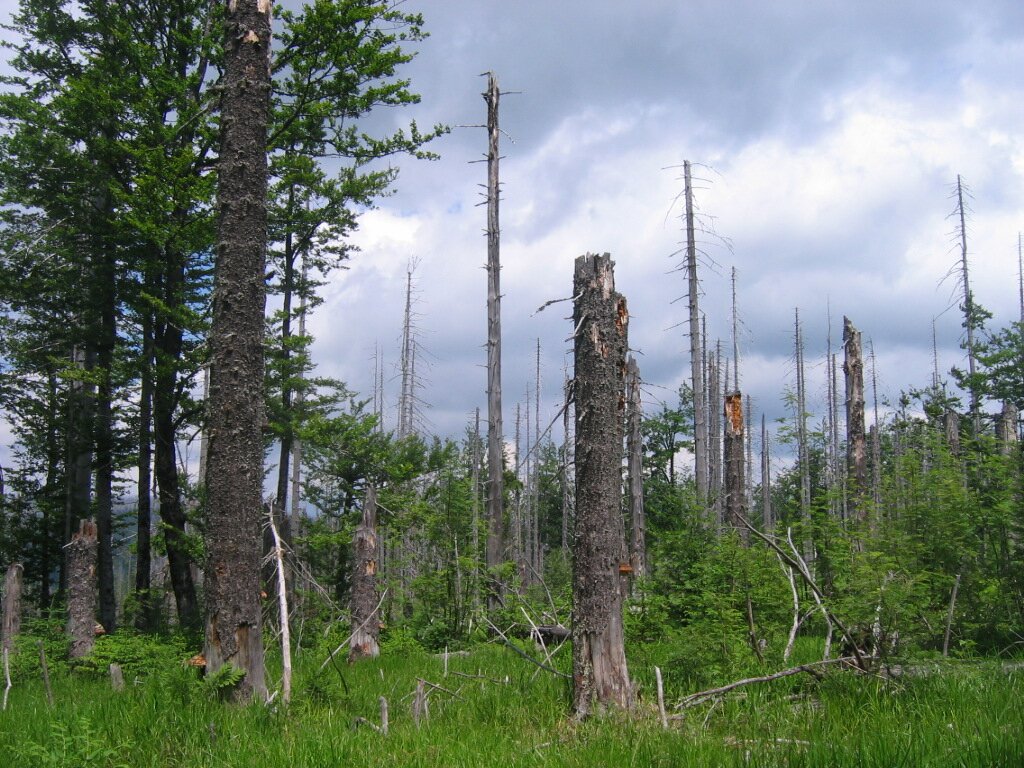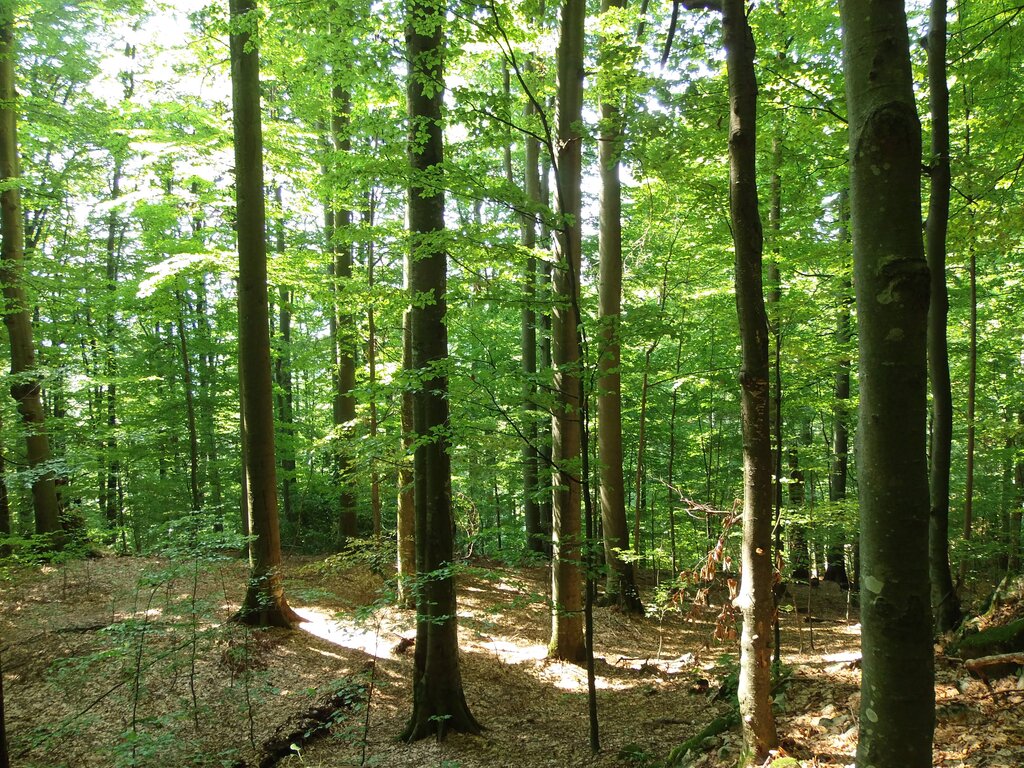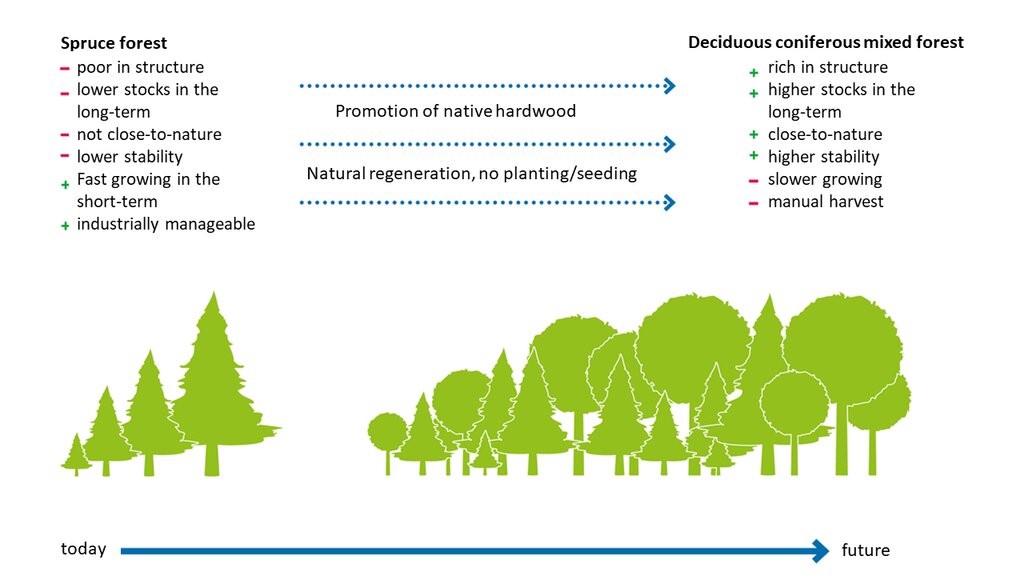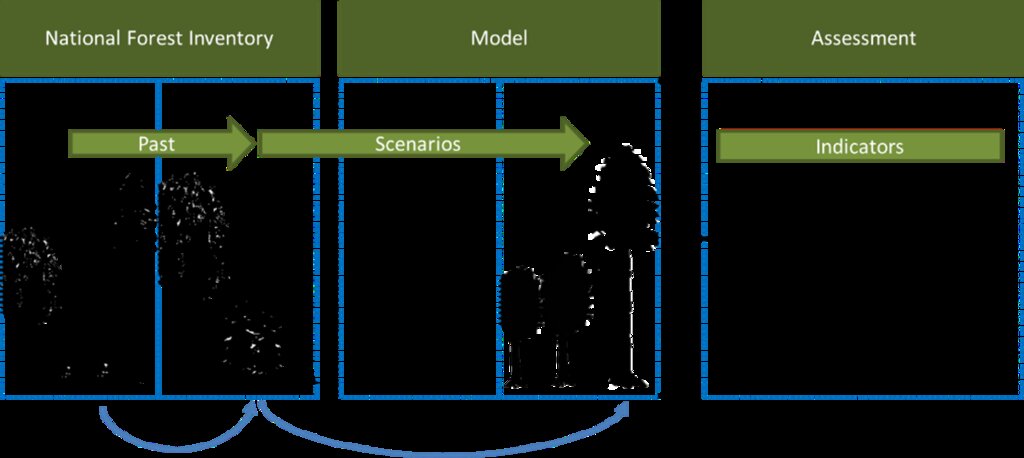Improved Forest management [德国]
- 创建:
- 更新:
- 编制者: Anke Benndorf
- 编辑者: –
- 审查者: Rima Mekdaschi Studer, William Critchley
Waldbewirtschaftung
technologies_7129 - 德国
查看章节
全部展开 全部收起1. 一般信息
1.2 参与该技术评估和文件编制的资源人员和机构的联系方式
SLM专业人员:
Böttcher Hannes
Öko-Institut e.V.
德国
有助于对技术进行记录/评估的项目名称(如相关)
Land Use Based Mitigation for Resilient Climate Pathways (LANDMARC)有助于对技术进行记录/评估的机构名称(如相关)
Öko-Institut (Öko-Institut) - 德国1.3 关于使用通过WOCAT记录的数据的条件
编制者和关键资源人员接受有关使用通过WOCAT记录数据的条件。:
是
1.4 所述技术的可持续性声明
这里所描述的技术在土地退化方面是否存在问题,导致无法被认为是一种可持续的土地管理技术?:
否
2. SLM技术的说明
2.1 技术简介
技术定义:
There are opportunities for robust forest management strategies in Germany to enhance land-based climate change mitigation. Through targeted measures, forest management can contribute to the continuous uptake of CO2 from the atmosphere by trees, and to the increase of carbon stocks in living and dead biomass, as well as in the soil.
2.2 技术的详细说明
说明:
Through targeted measures, forest management (FM) to enhance land-based climate change mitigation can be applied to all forested land within Germany. The aim is to increase carbon (C) uptake and storage in forests. FM options generally include forest protection (e.g. by taking forest area out of wood use), increasing forest carbon stocks (e.g. by extending the harvest cycle, and reducing the number of harvested trees), forest adaptation (e.g. increasing resilience of forest stands through the introduction of adapted species and varieties), and increasing the carbon stock in harvested wood products (e.g. by increasing the share of long-lived products).
This case study covers the whole 11.4 million hectares under forest in Germany. Coniferous trees make up 54% and deciduous trees cover 46% of the forest area. Half of the forests are privately owned, with an average property size of 3 ha. About 50% of private forest properties are under 20 ha and only 13% of private forest owners manage forests of more than 1,000 ha.
Incentive systems for rewarding ecosystem and environmental protection services in land use in general, and climate protection services in forest management in particular, should be established, so that forest owners have a source of income besides cutting and selling timber. Such a system should reward the efforts and ambitions to develop forests’ contribution towards a more climate resilient ecosystem that further provides society with clean air, water retention capacities, healthy soils, biodiversity and contributes crucially to the goal of C removal.
The measures to promote carbon sinks in the forest can be implemented on the existing forest area, which means that, in contrast to other land-based climate protection measures, there is no direct competition for land.
Synergies with the protection of biodiversity can result if native deciduous tree species are promoted and, above all, a higher proportion of older deciduous trees is left in the forest. In addition, a higher proportion of deadwood and a greater diversity of deadwood structures (lying, standing; different dimensions) also contribute. Promoting more deciduous trees in the forest can lead to higher groundwater percolation rates compared to coniferous stands.
Oeko-Institut has been developing the Forestry and Agriculture Biomass Model (FABio) since 2015. FABio-Forest describes the growth of individual trees as a distance-independent individual tree growth model. Parameters for tree growth and mortality are derived from National Forest Inventory (NFI) data. Assumptions on forest management as well as for climate change drive the future development of tree stands.
In addition, FABio includes modules for estimating carbon stored of wood products, forest litter and soil. The model is based on the following components:
•a model for the characterisation of tree growth based on diameter, height, site productivity and forest stand density;
•an ingrowth model for the characterisation of new trees based on stand density and tree species;
•a mortality model for the characterisation of dieback processes depending on tree species, site productivity, age and stand density;
•a deadwood model factoring in decomposition of dead trees;
•a soil carbon model simulating the decomposition of biomass in litter and soil over time depending on climate factors; and
•a model for the sorting and classification of wood products, i.e., to sort harvested trees into use categories and quantify carbon retention times of wood products.
FABio supports scenario analyses for various silvicultural practices and management scenarios and their effects on wood supply, carbon sequestration and aspects of nature conservation.
2.3 技术照片
2.5 已应用该技术的、本评估所涵盖的国家/地区/地点
国家:
德国
区域/州/省:
Germany
有关地点的进一步说明:
Nationwide
具体说明该技术的分布:
- 均匀地分布在一个区域
如果不知道精确的区域,请注明大致覆盖的区域:
- > 10,000 平方千米
技术现场是否位于永久保护区?:
否
注释:
Total area potentially covered by the improved forest management technology is 11.4 Mha: the technology is modeled for - and applicable to - all the forest area in Germany.
2.6 实施日期
如果不知道确切的年份,请说明大概的日期:
- 不到10年前(最近)
2.7 技术介绍
详细说明该技术是如何引入的:
- 作为传统系统的一部分(> 50 年)
3. SLM技术的分类
3.1 该技术的主要目的
- 保护生态系统
- 保持/提高生物多样性
- 适应气候变化/极端天气及其影响
- 减缓气候变化及其影响
- 创造有益的社会影响
3.2 应用该技术的当前土地利用类型
同一土地单元内混合使用的土地::
否

森林/林地
- (半天然)天然森林/林地
(半天然)天然森林/林地:具体说明管理类型:
- 选伐
- 清除枯木/剪枝
- 非木材森林的利用
(半)天然林类型:
- 温带大陆森林自然植被
- 温带山地系统天然植被
树木类型:
- 冷杉属物种(杉木)
- 云杉种(云杉)
- 松树属
- Quercus robur, Quercus petraea, Fagus sylvatica
以上的树木是落叶树还是常绿树?:
- 混合落叶或常绿
产品和服务:
- 木材
- 薪材
- 其它森林产品
- 自然保持/保护
- 娱乐/旅游
3.3 由于技术的实施,土地使用是否发生了变化?
由于技术的实施,土地使用是否发生了变化?:
- 否(继续问题3.4)
同一土地单元内混合使用的土地::
否
3.4 供水
该技术所应用土地的供水:
- 雨养
3.5 该技术所属的SLM组
- 天然和半天然森林管理
3.6 包含该技术的可持续土地管理措施

管理措施
- M2:改变管理/强度级别
- M5:物种组成的控制/变化
3.7 该技术强调的主要土地退化类型

生物性退化
- Bc:植被覆盖的减少
- Bh:栖息地丧失
- Bq:数量/生物量减少
- Bs:质量和物种组成/多样性的下降
- Bp:害虫/疾病增加,捕食者减少
3.8 防止、减少或恢复土地退化
具体数量名该技术与土地退化有关的目标:
- 防止土地退化
4. 技术规范、实施活动、投入和成本
4.1 该技术的技术图纸
技术规范(与技术图纸相关):
Spruce is the dominant tree species regarding coniferous trees growing outside their optimal habitat. So, a change from coniferous to deciduous coniferous mixed forest, mostly only affects spruce and not any other conifer tree species within Germany.
The drawing shows disadvantages (marked with a minus) and benefits (marked with a plus) of the forest types . The arrows indicate the measures to be taken to facilitate the transformation from a pure spruce forest to a mixed forest stand.
作者:
Hannes Böttcher
日期:
15/03/2018
技术规范(与技术图纸相关):
Work and information flow of the FABio forest model used for the SLM forest management.
FABio-Forest describes the growth of individual trees as a distance-independent individual tree growth model. Parameters for tree growth and mortality are derived from National Forest Inventory (NFI) data. Assumptions on forest management as well as for climate change drive the future development of tree stands
作者:
Klaus Hennenberg
日期:
15/03/2018
4.2 有关投入和成本计算的一般信息
具体说明成本和投入是如何计算的:
- 每个技术区域
注明尺寸和面积单位:
1 ha
其它/国家货币(具体说明):
€
如相关,注明美元与当地货币的汇率(例如1美元=79.9巴西雷亚尔):1美元=:
0.93
注明雇用劳工的每日平均工资成本:
39,50
4.3 技术建立活动
| 活动 | 时间(季度) | |
|---|---|---|
| 1. | fencing to allow undisturbed regeneration without game pressure | all year |
| 2. | planting new trees | spring, no frequency |
| 3. | game control to allow natural regeneration/planted trees to grow | hunting season |
4.4 技术建立所需要的费用和投入
如果您无法分解上表中的成本,请估算建立该技术所需要的总成本。:
10000.0
注释:
The range is between 5.000 - 15.000 €/ha per hectare, the cost vary, e.g. depending on what tree species are chosen, how many saplings are planted or how much natural regeneration is allowed. Total area is 11,4 mio hectares.
4.5 维护/经常性活动
| 活动 | 时间/频率 | |
|---|---|---|
| 1. | tending, thinning of young trees for managing tree species composition | every few years |
| 2. | monitoring of areas taken out of use | througout the year |
| 3. | wildlife management | hunting season, 1-2 per year |
4.6 维护/经常性活动所需要的费用和投入(每年)
如果您无法分解上表中的成本,请估算维护该技术所需要的总成本。:
2000.0
注释:
The range is between 500 - 4000 € /ha depending, among others, on the age and structure of the forest stands. If areas are taken out of wood production or leaving dead wood on the site after calamities then opportunity costs occur in the range between 200 €/ha and 1000 €/ha. Souce: https://www.bmuv.de/download/foerderrichtlinie-klimaangepasstes-waldmanagement-plus. Total area is 11,4 mio hectares.
4.7 影响成本的最重要因素
描述影响成本的最决定性因素:
Availability of labor, availability of seedlings, density of deer population, costs for fencing.
5. 自然和人文环境
5.1 气候
年降雨量
- < 250毫米
- 251-500毫米
- 501-750毫米
- 751-1,000毫米
- 1,001-1,500毫米
- 1,501-2,000毫米
- 2,001-3,000毫米
- 3,001-4,000毫米
- > 4,000毫米
指定年平均降雨量(若已知),单位为mm:
740.00
注明所考虑的参考气象站名称:
Evaluation from the Federal Environment Agency of Germany based on data provided by the German Weather Service (DWD)
农业气候带
- 半湿润
The length of the growing period in Germany is around 200 days. Germany is part of the temperate, rainy climate zone of the mid-latitudes. The annual mean temperature from 1961 to 1990 was 8.2°C.
5.2 地形
说明该技术是否专门应用于:
- 不相关
关于地形的注释和进一步规范:
Forests in Germany are found in all different types of landscapes. In the north everything is rather flat, the center of Germany consists of mountains around the elevation of up to 1000 m a.s.l and the very south has high mountain ranges of an altitude of almost 3000 m a.s.l.
5.3 土壤
如有可能,附上完整的土壤描述或具体说明可用的信息,例如土壤类型、土壤酸碱度、阳离子交换能力、氮、盐度等。:
Same as above as the SLM covers the entire area of the country all different soils with the above mentioned parameters are represented that occur in the respective climatic zone.
5.4 水资源可用性和质量
地下水位表:
5-50米
水质(未处理):
良好饮用水
水质请参考::
地下水
水的盐度有问题吗?:
否
该区域正在发生洪水吗?:
是
规律性:
偶然
关于水质和水量的注释和进一步规范:
Flooding occurs only after very heavy rainfall, when certain weather conditions apply. The latest major floods were in 2003, 2013 and 2024.
5.5 生物多样性
关于生物多样性的注释和进一步规范:
It differs very much from region to region, depending on what type of forest is there, regarding mountainous or flat area, species composition and age structure.
5.6 应用该技术的土地使用者的特征
定栖或游牧:
- 定栖的
生产系统的市场定位:
- 商业/市场
个人或集体:
- 个人/家庭
- 团体/社区
机械化水平:
- 机械化/电动
性别:
- 女人
- 男人
土地使用者的年龄:
- 中年人
- 老年人
5.7 应用该技术的土地使用者使用的平均土地面积
- < 0.5 公顷
- 0.5-1 公顷
- 1-2 公顷
- 2-5公顷
- 5-15公顷
- 15-50公顷
- 50-100公顷
- 100-500公顷
- 500-1,000公顷
- 1,000-10,000公顷
- > 10,000公顷
这被认为是小规模、中规模还是大规模的(参照当地实际情况)?:
- 大规模的
注释:
This applies to all to different forest owners with different forest land sizes. The average size of privately owned forest area is 2,4 ha. Publicly owned forest is typically larger.
5.8 土地所有权、土地使用权和水使用权
- all of the above
- all of the above
- no information
土地使用权是否基于传统的法律制度?:
否
5.9 进入服务和基础设施的通道
健康:
- 贫瘠
- 适度的
- 好
教育:
- 贫瘠
- 适度的
- 好
技术援助:
- 贫瘠
- 适度的
- 好
就业(例如非农):
- 贫瘠
- 适度的
- 好
市场:
- 贫瘠
- 适度的
- 好
能源:
- 贫瘠
- 适度的
- 好
道路和交通:
- 贫瘠
- 适度的
- 好
饮用水和卫生设施:
- 贫瘠
- 适度的
- 好
金融服务:
- 贫瘠
- 适度的
- 好
6. 影响和结论性说明
6.1 该技术的现场影响
社会经济效应
生产
木材生产
生态影响
水循环/径流
水量
水质
地表径流
地下水位/含水层
蒸发
土壤
土壤水分
养分循环/补给
生物多样性:植被、动物
植被覆盖
生物量/地上C
植物多样性
动物多样性
栖息地多样性
减少气候和灾害风险
碳和温室气体的排放
对现场影响的评估(测量)进行具体说明:
The model provides information that if timber extraction is reduced that it will impact positively the C sequestration rate and C storage of the forest. There are no other impacts modeled explicitly but impacts can be expected also on the water cycle, soil quality, and biodiversity.
6.2 该技术的场外影响已经显现
对场外影响(测量)的评估进行具体说明:
not assessed
6.3 技术对渐变气候以及与气候相关的极端情况/灾害的暴露和敏感性(土地使用者认为的极端情况/灾害)
渐变气候
渐变气候
| 季节 | 增加或减少 | 该技术是如何应对的? | |
|---|---|---|---|
| 年温度 | 增加 | 适度 | |
| 季节性温度 | 夏季 | 增加 | 适度 |
| 年降雨量 | 减少 | 适度 | |
| 季雨量 | 夏季 | 减少 | 适度 |
气候有关的极端情况(灾害)
气候灾害
| 该技术是如何应对的? | |
|---|---|
| 干旱 | 未知 |
生物灾害
| 该技术是如何应对的? | |
|---|---|
| 昆虫/蠕虫侵扰 | 未知 |
6.4 成本效益分析
技术收益与技术建立成本相比如何(从土地使用者的角度看)?
长期回报:
积极
技术收益与技术维护成本/经常性成本相比如何(从土地使用者的角度看)?
长期回报:
积极
注释:
Regarding forests, long-term refers to a time span of a minimum of 60 years.
6.5 技术采用
如若可行,进行量化(住户数量和/或覆盖面积):
unknown
6.7 该技术的优点/长处/机会
| 土地使用者眼中的长处/优势/机会 |
|---|
| The payment for ecosystem services creates a new field of income and thus diversifies its' revenues. |
| The establishment of a more resilient forest provides benefits to the forest owner as he can longer profit from the resources the forest produces/provides. |
| 编制者或其他关键资源人员认为的长处/优势/机会 |
|---|
| It is expected that there will be an increase of biodiversity as a higher diversity in tree species attracts other fauna and new habitats are created. Areas taken out of use might contribute to that aspect as well. |
| Natural development of forest sites taken out of use provides the opportunity to have old-growth trees in the forest again and diversify the age structure in forested areas. Old trees also provide great habitats to a variety of different species. |
| The increase of wood stock as less trees are harvested will increase CO2 sequestration. |
6.8 技术的弱点/缺点/风险及其克服方法
| 土地使用者认为的弱点/缺点/风险 | 如何克服它们? |
|---|---|
| reduction of timber supply | import, reduce demand |
| 编制者或其他关键资源人员认为的弱点/缺点/风险 | 如何克服它们? |
|---|---|
| management of multi species forests requires silvicultural knowledge | training |
7. 参考和链接
7.1 信息的方法/来源
- 与SLM专业人员/专家的访谈
in-house specialists: 4
- 根据报告和其他现有文档进行编译
4 (s. references below)
注释:
Data collection for a national forest inventory takes about 2 years ahead of the official release. It is similar regarding the C inventory, data collection was done in the year ahead.
7.2 参考可用出版物
标题、作者、年份、ISBN:
Forest Vision Germany - Description of methodology, assumptions and results , Böttcher et al., 2018
可以从哪里获得?成本如何?
https://www.oeko.de/fileadmin/oekodoc/Forest-Vision-Methods-and-Results.pdf
标题、作者、年份、ISBN:
Referenzszenario der Holzverwendung und der Waldentwicklung im UBA-Projekt BioSINK, Pfeiffer et al., 2023
可以从哪里获得?成本如何?
file:///C:/Users/a.benndorf/Downloads/WP-Referenzszenario-BioSINK.pdf
标题、作者、年份、ISBN:
Zukunftsaufgabe Waldanpassung, ANDREAS BOLTE, MARKUS HÖHL, PETRA HENNIG, TOBIAS SCHAD, FRANZ KROIHER, BJÖRN SEINTSCH, HERMANN ENGLERT, LYDIA ROSENKRANZ, 2018
可以从哪里获得?成本如何?
Zukunftsaufgabe Waldanpassung
7.3 链接到网络上的相关信息
标题/说明:
Portal on Forest Inventories
URL:
https://bwi.info/start.aspx
标题/说明:
Förderrichtlinie Klimaangepasstes Waldmanagement PLUS
URL:
https://www.bmuv.de/download/foerderrichtlinie-klimaangepasstes-waldmanagement-plus
链接和模块
全部展开 全部收起链接
无链接
模块
无模块


